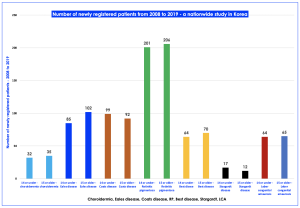Researchers at the Department of Ophthalmology, Seoul National University College of Medicine, South Korea, have conducted a study to evaluate the national incidence of rare retinal diseases to accurately understand the prevalence and healthcare requirements over the coming decade. According to the research publication, there is very little research on the incidence of rare retinal diseases in South Korea and “knowing the exact epidemiology of rare diseases will significantly help set and research target diseases.” Based on this epidemiological work, researchers stated that the objective “will help set up health policies and provide helpful information for interracial studies.”
The research used a retrospective population-based cohort study, based on the national sample cohort data of the NHIS of South Korea from 2006 to 2019. The project included 48,222,537 Korean nationals (who maintained the status of health insurance subscribers or medical benefit recipients for one year in 2006). Fourteen ocular diseases are registered and recorded in the Korea Disease Control and Prevention Agency, including Cogan’s syndrome, Avellino corneal dystrophy (homozygous), keratoconus, choroideremia, Eales disease, Coats disease, retinitis pigmentosa, Best disease, Stargardt disease, unspecified hereditary retinal dystrophy, LCA, chronic progressive external ophthalmoplegia, Kearns- Sayre syndrome and ocular motor apraxia, Cogan type. In the current study, their research was focused on retinal diseases. They analyzed clinical records of 1,126,250 South Korean patients calculated the number of newly registered patients of rare retinal disease over an eleven (11) year period:
Figure 1. The incidence of rare retinal diseases, grouped according to “14 years of age under”, and “15 years of age older”. Retinitis pigmentosa was the highest incidence (28.45 (95% CI 25.59–31.30) in total, 29.33 (95% CI 23.67–34.99). Summarized from Kim M et al, entitled: 12-year cumulative incidence rate of rare retinal diseases: a nationwide study in Korea, Eye (Lond). 2025 Jan 4 (https://doi.org/10.1038/s41433-024-03565-5).
Following their analysis, the 12-year cumulative incidence per 100,000 people in rare retinal diseases was 0.66 to 28.45. Among them, retinitis pigmentosa revealed the highest incidence (28.45 (95% CI 25.59–31.30) in total. There were 407 new retinitis pigmentosa patients and the 12- year cumulative incidence in childhood was 8.03 (95% CI 5.07–11.00) and 28.45 (95% CI 25.59–31.30) later in life. Late-onset rare retinal diseases such as Eales diseases and Best diseases had higher incidence rates in adults. The incidence difference according to gender was not significant. The research study provides very valuable epidemiological data aimed to assess public healthcare requirements over the coming years, not least of all clinical trial recruitment requirements for new experimental treatments in both academic and commercial settings.

